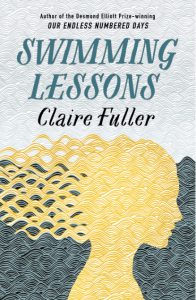
Swimming Lessons is English author Claire Fuller’s second novel. After coming across more than one raving review by book bloggers and critics, I decided I had to read it.
Flora and Nan’s mother has disappeared twelve years ago. One day, their father, Gil Coleman, thinks he’s seen her and while trying to get a better look accidentally falls from a seafront. Nan, the older sister, a nurse, calls Flora and begs her to come home and help her look after their dad.
Unlike Gil and Nan, Flora doesn’t believe that her mother has drowned. She thinks that she simply chose to leave and might still return one day.
After the first chapter in which Flora travels to her childhood home, a swimming pavilion, the narrative splits. The parts in the present are told from Flora’s POV, the parts in the past are written in the form of letters Ingrid writes to Gil before she disappears. Ingrid hides the letters in the pages of Gil’s books. Gil Coleman, who is the famous author of a scandalous book, has an interesting hobby. He collects old books. Not because of the books but because of the things he finds in them— the notes and drawings of their readers. In one of these he finds a letter from his missing wife. Ingrid’s letters unfold their complex, difficult, and destructive marriage.
Most readers seem to have liked the marriage story told by Ingrid in the letters. While I found some elements interesting, overall, the parts set in the present, spoke to me much more. The most interesting element of Ingrid’s story is her feelings for her children. She doesn’t relate to her two daughters. The first one, Nan, was an accident and somehow Ingrid always saw her as an independent being. Flora, the third, is very much Gil’s daughter. I guess that’s why the parts in the present are told from her and not from Nan’s point of view. She adores and idolizes her father. Finding out the truth about her parent’s marriage is more of a surprise and a shock to her than it is to the reader. One of the tragedies of Ingrid’s life is that the child she relates to the most was stillborn. When she’s pregnant with him, she already knows that Gil is unfaithful and she’s very lonely. She projects so much on this child and is sure he will become her companion. When he dies, she feels like she’s lost her only true child and her chance at happiness and companionship. I found this extremely sad and problematic for everyone involved. For Ingrid, because she lost that baby and for her two girls because they mean less to their mother than a child who didn’t even live.
The parts told by Flora were those I could relate to the most. They show how difficult it is to live with a family secret and what a challenge it can be, coming from a dysfunctional family, to have healthy relationships.
One of the main themes of the novel is ambiguous loss. There’s a story one character tells the others, in which a child gets lost and it mirrors Ingrid’s story. The loss is magnified because they never get closure. It’s possible she’s dead but it’s just as possible, she left them. Gil and Nan, both believe she’s dead and have moved on, but Flora, for the longest time, cannot move on as she’s still hoping her mother’s out there somewhere.
Whole books have been written about ambiguous loss. There are other forms of ambiguous loss, not only those, in which the body of the disappeared was never found but also those in which the mind has gone but the body’s still around, like in the case of dementia or Alzheimer patients. I haven’t experienced anything like this but I always thought it must be devastating. It’s an important topic and I loved how subtly it was explored in this novel.
This is one of those books I enjoyed far less while reading it than after finishing it. I’m not always keen on split narratives. I often prefer one narrator/POV and going back and forth between two or more can get on my nerves. But when a book is really good, it can come together as whole, once we finish reading. And that was the case here. The longer I thought about it, the more I liked it. I found the characters, especially quirky Flora, interesting and relatable and I absolutely loved the sense of place. The descriptions of the swimming pavilion and the surrounding landscape of marshes and ponds, is what held the book together. The imagery was so strong that I can still picture the place with great detail. The ending was unexpected and powerful.
If you like stories of dysfunctional families and family secrets, books with a strong sense of place, and fully rounded, complex characters, you might enjoy this subtle, haunting story that lingers in the mind long after the book is finished.
